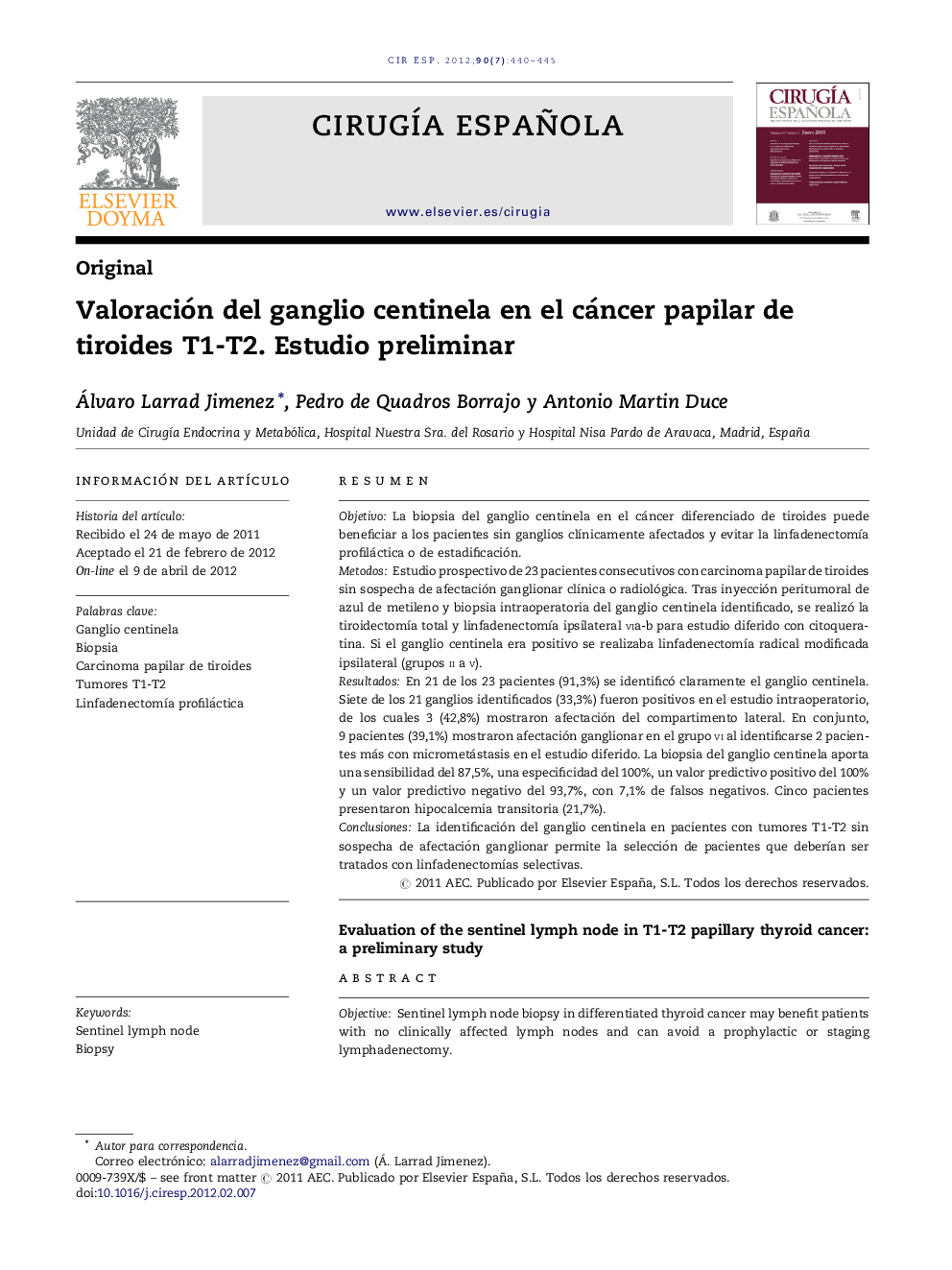| Article ID | Journal | Published Year | Pages | File Type |
|---|---|---|---|---|
| 4252761 | Cirugía Española | 2012 | 6 Pages |
ResumenObjetivoLa biopsia del ganglio centinela en el cáncer diferenciado de tiroides puede beneficiar a los pacientes sin ganglios clínicamente afectados y evitar la linfadenectomía profiláctica o de estadificación.MetodosEstudio prospectivo de 23 pacientes consecutivos con carcinoma papilar de tiroides sin sospecha de afectación ganglionar clínica o radiológica. Tras inyección peritumoral de azul de metileno y biopsia intraoperatoria del ganglio centinela identificado, se realizó la tiroidectomía total y linfadenectomía ipsilateral via-b para estudio diferido con citoqueratina. Si el ganglio centinela era positivo se realizaba linfadenectomía radical modificada ipsilateral (grupos ii a v).ResultadosEn 21 de los 23 pacientes (91,3%) se identificó claramente el ganglio centinela. Siete de los 21 ganglios identificados (33,3%) fueron positivos en el estudio intraoperatorio, de los cuales 3 (42,8%) mostraron afectación del compartimento lateral. En conjunto, 9 pacientes (39,1%) mostraron afectación ganglionar en el grupo vi al identificarse 2 pacientes más con micrometástasis en el estudio diferido. La biopsia del ganglio centinela aporta una sensibilidad del 87,5%, una especificidad del 100%, un valor predictivo positivo del 100% y un valor predictivo negativo del 93,7%, con 7,1% de falsos negativos. Cinco pacientes presentaron hipocalcemia transitoria (21,7%).ConclusionesLa identificación del ganglio centinela en pacientes con tumores T1-T2 sin sospecha de afectación ganglionar permite la selección de pacientes que deberían ser tratados con linfadenectomías selectivas.
ObjectiveSentinel lymph node biopsy in differentiated thyroid cancer may benefit patients with no clinically affected lymph nodes and can avoid a prophylactic or staging lymphadenectomy.MethodsA prospective study was conducted on 23 consecutive patients with papillary thyroid carcinoma with no clinical or radiological suspicion of lymph involvement. After injecting methylene blue around the tumour during the biopsy of the identified sentinel lymph node, a total thyroidectomy and a via-b ipsilateral lymphadenectomy was performed for the later study with cytokeratin. If the sentinel lymph node was positive, a modified ipsilateral radical lymphadenectomy was perfumed (groups ii to v).ResultsThe sentinel lymph node was clearly identified in 21 of the 23 patients (91.3%). Seven (33%) of the 21 lymph nodes identified were positive in the intra-operative study, of which 3 (42.8%) demonstrated involvement with the lateral compartment. All together, 9 patients (39.1%) showed lymph node involvement group vi, with two more patients being identified with micro-metastases in the later study. Biopsy of the sentinel lymph node had a sensitivity of 87.5%, a specificity of 100%, a positive predictive value of 100% and a negative predictive value of 93.7%, with 7.1% false negatives. Five patients (21.7%) had transient hypocalcaemia.ConclusionsThe identification of the sentinel lymph node in patients with T1-T2 tumours with no suspicion of lymph node involvement helps in the selection of patients who should be treated with selective lymphadenectomies.
